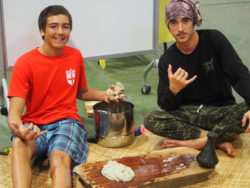Living History
By Jack Kiyonaga, Reporter

Photo by Jack Kiyonaga.
Student artwork and writing filled “The Barn” at Molokai High School on Feb. 25. The event was
the seventh annual ‘Aha Opio O Molokai, dedicated to celebrating Hawaiian culture and education.
Student projects ranged from artwork based on Hawaiian myths, to wood working, to live action poi pounding.
The student projects were intended to “celebrate innovation” and align with “one or more of the HA [Hawaii Dept. of Education framework] outcomes: Belonging, Responsibility, Excellence, Aloha, Total Well Being, and Hawaii,” according to the event’s website.
The day was an opportunity for students to fully engage with Hawaiian culture and be reminded of the hard-won history by which this education came about.
The keynote speakers for the event were comprised of key Hawaiian activists who had played a role in the historic occupation of Kaho’olawe in the 1970s. These leaders included Walter Ritte and Richard Sawyer who had occupied the island for 38 days in response to unceasing U.S. military bombings.
Scarlett Ritte, one of the panel speakers, explained that those on stage were “living history.”
“We can give back to our future generations by sharing our stories, our sacrifice, our losses — it all brought us to today,” she said.
The event also premiered the re-printing of the book Na Mana’o Aloha o Kaho’olawe. The book is an account of Sawyer and Ritte’s experience occupying the island and has writings from Molokai’s George Helm and Emmett Aluli, who were also leaders in the movement to stop the bombing of Kaho’olawe. It has been out of print for many years. Loretta Ritte explained that she was moved to re-print the book after her grandchildren were unable to find information on the protest and occupation of Kaho’olawe in their high school classes.
The panel of speakers spoke at length about their experience in the “Hawaiian Renaissance” of the 1970s. They spoke of friends lost in Helm, Aluli and Kimu Mitchell, and the true victory of seeing Hawaiian language and culture taught in schools today.
“They found Heaven — we live in Heaven,” said Sawyer. “And it was through the gateway of Kaho’olawe.”











Don't have a Molokai Dispatch ID?
Sign up is easy. Sign up now
You must login to post a comment.
Lost Password